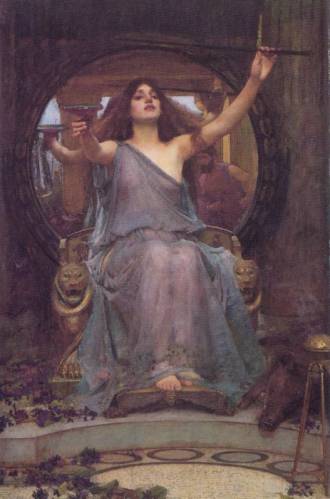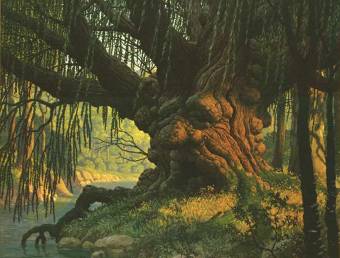
Page Index
 Celtic Art Forms Celtic Art Forms  Celtic Cross Celtic Cross  Key and Labyrinth Designs Key and Labyrinth Designs  Symbolic Meanings of Animals Symbolic Meanings of Animals   Portcullis Designs Portcullis Designs  Spiral Designs Spiral Designs  Zoomorphic Designs Zoomorphic Designs  Celtic Tree of Life Celtic Tree of Life  Celtic Knots Celtic Knots 

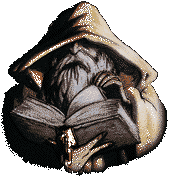
Celtic Art Forms
Celtic art fascinates Celtic folk, non-Celtic people, artists and those that can't even make stick figures. The art is characterized by inter-woven ropes of intricate knot work which can be seen painted, carved, or placed on fine jewelry or other metal crafts. Many examples of Celtic art survive, and there is a renewed interest in it. After you have spent some time studying the way Celts viewed their world, their artwork will seem to suggest to you some of their cosmic beliefs. The waxing and waning energy patterns which are part of all life can be seen in the knots, twists, turns, and swirls of their drawings and carvings. Many art historians believe that the Picts, the pre-Celtic people of northern Scotland, originated the knot work we think of today as being Celtic.
On this page I have included some examples of the various styles of Celtic artwork and an explanation of what they represent.
|
|
Celtic Cross
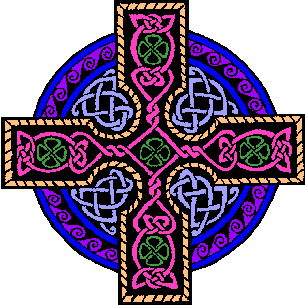
Although today the symbol we usually think of when we hear the word cross brings to mind the Christian cross, the Celtic cross is much older. The oldest example of crosses are those engraved or painted on flat pebbles, dating from 10,000 B.C.E., found in a cave in the French Pyrenees. These ancestor stones were believed to contain the spirits of the dead.
The Celtic cross symbolizes the four roads of the four corners of the earth(forerunners of our parallels of latitude and longitude), and the meetings of these roads at a central point formed a cross, indicating the center of the world body.
The center of the cross is also representative of the center place where all forces of Life, source of the four mystic rivers, summit of the world mountain, and other interpretations of the X that marks the spot.
|
|
Specific Celtic Knots,
- what do they signify -

Celtic Oval
The Celtic spiral in its purest and simplest form symbolizes eternity, continuity, and the never endlessness of life. Created and passed down by early generations of Celtic peoples in Europe, England, Scotland, Wales and Ireland, the Celtic spiral can be traced back to 2500 BCE.

Celtic Triple Drop
The three-sided knot represents the three forces of nature...earth, fire and water. The single continual line symbolized unity and strength as well as completeness of spirit and being.

Celtic Round
Found on stone crosses in Eastern Ireland, similar circle designs represent and completeness of self. The outer shape symbolizes the sun's orb, revered by ancient Celts. The three interlocking spiral knots represent earth, fire, and water.
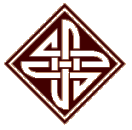 Celtic Square
Celtic Square
Of Scottish origin, the single continuous line of this knot symbolizes love and fidelity. This design is part of what is known as the Celtic love knot.
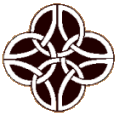
Celtic Four
A symbol of good fortune, the four distinctive interlocking circles of this design also stand for the season. The double lines around the edge symbolize friendship or love between two people who are separate yet together.

Serpent Knot
This knot design comes from the illuminated pages of the Book of Kells, which according to legend, was written by St. Columba and his monks at the monastery at Kells, Ireland in the 6th century CE. The intricate patterns represent the endlessness of eternal life.
|
|
Key and Labyrinth Designs
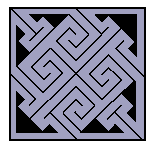
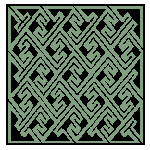
The Sacred Dance Key and step patterns are really spirals in straight lines. When connected, they become a processional path, leading through a complex maze to the sacred omphalos (the navel) at the center - the point where Heaven and Earth are joined.
Labyrinths, like wells, were primarily religious objects and were incorporated into the Christian church. On the solar celebrations and other religious festivals, the adept danced the "Sacred Dance" barefoot to absorb the earth's energies, through the Labyrinth. This was a journey through progressive levels of experience, physical, mental and spiritual, until the vortex at the center was reached.
The lozenge either has a dot in the center, or is divided into four equal parts with a dot in each compartment. This diamond shape has appeared with triangles on shrine walls, vases, seals, and, typically, on the pregnant belly or other parts of the Pregnant Goddess, starting in the seventh millennium B.C.E.
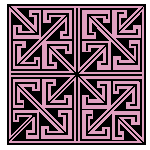
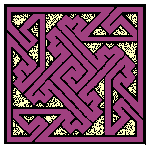
The lozenge design is thought to be a symbol of fertility because of its vulva configuration. A lozenge with a dot in the four corners may denote planting in all four directions, whereas many dots within a diamond may signify multiplication of the seed, a general resurgence of life in the sown field.
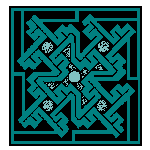
The lozenge that is divided in equal parts suggests that all fat parts of the body were significant, considered to be growing, or pregnant. This sign, apparently, is representative of the Great Mother from whose womb we were given birth, and in whose womb still rest the countless unborn.
Portcullis Designs
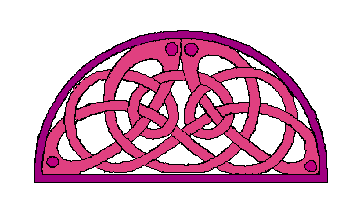
The doors that lead to the inner, or Solar Sphere, were often adorned with a key pattern lattice archway. The combination of these two symbols was to prepare the apprentice for their journey into the Great Mysteries. The willingness to pass through the threshold was the first step every Initiate at one time took. This was a journey through progressive levels of experience, physical, mental, and spiritual, until the vortex at the center was reached, as conveyed by the key pattern/labyrinth design of the lattice archway above the door.
Spiral Designs
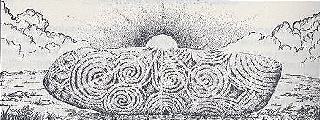
Both single and double spirals were among the most sacred signs of Neolithic Europe. They appeared on megalithic monuments and temples all over the continent and the Celtic islands. Spiral oculi (double twists resembling eyes) appear prominently in places like the threshold stones at Newgrange in Ireland.
The spiral is the cosmic symbol for the natural form of growth; a symbol of eternal life, reminding us of the flow and movement of the cosmos. The whorls are continuous creation and dissolution of the world; the passages between the spirals symbolized the divisions between life, death, and rebirth. The spiral dance that witches perform in sacred circles demonstrates the concept of as above, so below; mirroring the macrocosmic order of the heavens, the gyratory movement representing the whirling of the stars above the fixed earth. Winding in, the spiral dance establishes the still center within, approaching the heart of the universe, or the womb which will give birth. Winding out, the spiral dance births the Spirit back to its divine source of existence.

Zoomorphic Designs
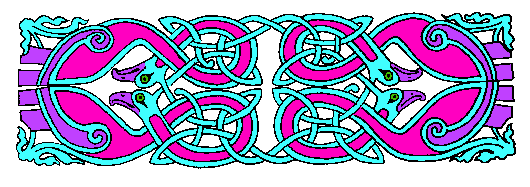
Animals and birds were considered sacred and were often used to represent the Ancient Ones. Shape shifting was a common attribute of the Celtic goddesses and some of the gods. These semi-mythological characters, who adopted the form of an animal, were soon turned into art.

Zoomorphic and anthropomorphic ornaments are symbols which show us that nothing is as it first appears. Often, such artwork looks like a beautiful mosaic of miscellaneous design and color until, upon closer examination, one identifies a head, or a tail, or a plant, all of which are interwoven with each other. These intricate patterns first appeared in the Bronze Age art of Ireland. The artisans fashioned them into a complicated contortion of bodies, but they kept the motif still logical and conforming with nature.

Because it was forbidden to duplicate Danu's creation in a perfect state, it is not unusual for animals to appear with human hands and feet, or even to see a calf's head on an eagle's body, or a human being with animal parts.
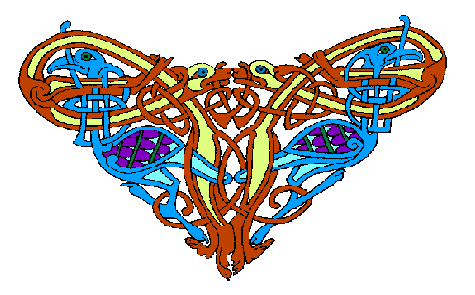

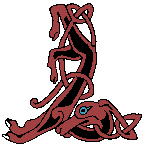

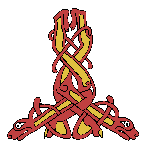
|
|
Celtic Tree of Life
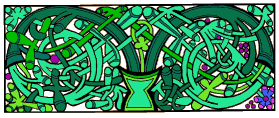
The 'Tree of Life' concept is found in many cultures worldwide including Celtic. It is often regarded as an all-nourishing, all-giving Mother, many myths tell of the Tree of Life or World Tree as being involved in the creation of the universe. Britain was once covered by huge oak forests and tree reverence is a major feature within the Celtic religion. They reflect a link between the upper and lower worlds.
The art forms represented here come from the 'Book of Kells'. According to George Bain, author of "Celtic Art the methods of construction", the Celtic 'Tree of Life' completes the total of created life, the seven created beings of the Celtic world, Plant, Insect, Fish, Reptile, Bird, Animal and Man. There is a distinct similarity between these and examples from Buddhist art, perhaps helpful in proving the Celtic migrations to these lands.
In most 'Tree of Life' examples, the plants and trees have a logical growth pattern with branches from a main stem to form cornucopia from which other branches with leaves and fruits emerge. It is interesting to note that in most examples the plants bear a remarkable resemblance to mistletoe, one of the Druids most sacred plants.
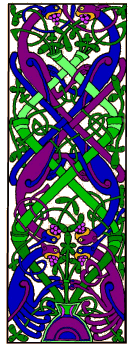 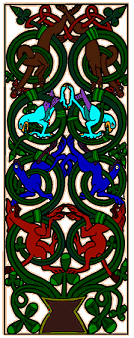
|
|
The Oak Men
Information on the Oak Men coming soon !
|
|
Symbolic Meanings of Some of the Animals used in Celtic Art

Birds
Associated with death transitions in Celtic mythology.

Boar/Sow
The boar is a symbol of masculine power. The meat of the boar was served at Otherworld feasts for the deities.
The sow is associated with some Crone/Mother Goddesses, such as Cerridwen, and with Otherworldly feasts. The pig is the archetypal symbol of plenty, healing, and shape shifting.

Bull
Figures heavily in what little Celtic creation mythology surviving from Ireland, though this may not be Irish at all, but rather a myth derived from a Middle Eastern source. In the Celtic world, the bull was a symbol of virility, sovereignty, and wealth. The famous Irish legend, The Cattle Raid of Cooley, surrounds the taking of a famous bull. In Ancient Ireland, a tabhfheis, or a highly ritualized "feast of the bull", always preceded the crowning of a new High King.
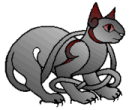
Cat
unlike many other Indo-European cultures, the Celts did not revere cats, though there are many references to them in Celtic mythology. Archtypally they serve the same guardian function as demons/angels in the Judeo-Christian myths. Three mythic references to cats which are prominent are; one, a cat which helps to guard the gates of the Otherworld; two, one who is able to shape shift into a ball of fire; and three, one called Irusan of Knoweth who stole humans like the fairy. Cat-like monsters were also believed to dwell in dark caves.
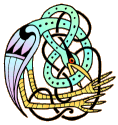
Crane
Numerous Celtic myths tell us of a heroic figure or deity who was changed into a crane such as Aife, the Lady of the Lake, or Munanna. Archtypally this bird means an apparent, rather than substantive, change a sign of, or punishment for, deception.
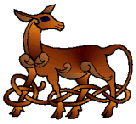
Deer
the deer was the principal animal hunted by the Celts for food. The doe was associated with most woodland Goddesses, such as Saba and Flidais, and is their totem animal. The stag was often seen as the incarnate form of woodland Gods such as Cernunnos. White stags were considered to be from the Otherworld and, in myth, their appearance always heralded some profound change in the lives of those in the story. Considered in Celtic mythology to be among the oldest creatures in existence.
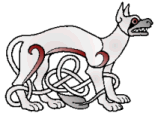
Dogs
Sacred to the faeries of Ireland and Scotland probably because they were held in high regard by the Tuatha de Danann. Many Celtic myths involve dogs or dog familiars, who belonged to heroic figures or deities, and wars, were often fought for and over them such as the one between Fionn MacCumhal and King Arthur. Examples of the importance of Celtic dogs are found in the myths of Gwyn Ap Nuad, Cuchulain, Amaethaon, and Taliesin. Dogs are also the archetypal symbols of shape shifters.
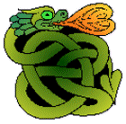
Dragon
the dragon is another mighty magical animal that appears in British and Welsh stories. It is, of course, a creature of fire but is also related to the Power of the Land. Another word for Ley Lines is Dragon Lines. Another name for raising power is to invoke the "Eye of the Dragon". The whole Earth was viewed by the Druids as the body of the Dragon. Menhirs and stone Circles were located at great Power nodes. The Celts also called Dragons 'Fire Drakes'.
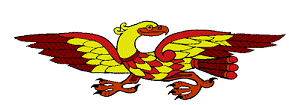
Eagle
Eagles were the feared scavengers of Europe and were usually linked to death Gods, such as Beli, in the same way as the crow was linked to death Goddesses. In Welsh mythology, Llew was turned into an eagle at the moment of his murder.
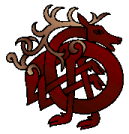
Horse
Horses were sacred to many Indo-European Goddesses, and often filled the archetypal place given to cats in other cultures. They were linked to the night, the moon, mystery, and magic. Nightmares, a name which is derived from that of the female horse, were thought by the Celts to be brought by a visiting horse Goddess such as Epona or Mare. In most Celtic myths the horses are black or white.
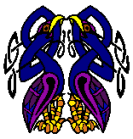
Ousel
(Usually spelled Ouzel in the United States.) This water bird is known for its tenacious and deceptive personality. While it looks harmless enough, it is revered for its ability to staunchly defend itself and its flock. In myth, the Ousel of Cilgwri once picked a smith's hammer down to the size of a small nut
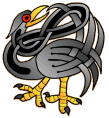
Raven or Crow
The Crow is deeply linked to Crone Goddesses such as Badb, and to Goddess of war or death like the Morrigan.
The Raven is similar to the crow in that it is deeply associated with death deities. But, while the crow is usually reserved as a spirit form for feminine deities, the raven has been the Otherworldly body for both Gods and Goddesses. Like the crow, it flew over Celtic battlefields as the deity incarnate. The raven is most closely associated with the Irish/Welsh God Bran
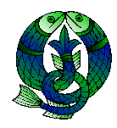
Salmon
While the airborne creatures Archtypally linked the Celts to the Underworld, sea creatures linked them to great knowledge, sacred mysteries, and deep emotion, (typically, only deities of great wisdom and temperament ruled the Celtic seas). Most prominent among these wise sea creatures was the Salmon of Knowledge. The myths of Nudons and Fionn are among the many dealing with this fish. It is said to have acquired its great knowledge from eating the Nine Hazels of Wisdom that fell from the Tree of Knowledge. This fish is said to be among the oldest of living creatures.
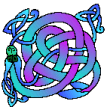
Serpent
Represents the cyclic nature of life due to the annual shedding of its skin. It is a phallic symbol, a symbol of the Triple Goddess, and of the earth mysteries. It is important to the Druids, and is found on much old Celtic jewelry. Contrary to popular myth, there are snakes in Ireland, though they are pretty much confined to the rugged western region of the Island.
|
|
Celtic Knots
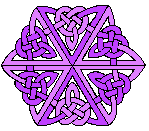
The Celtic knot symbolizes the Thread of Life. To the Celts, the human soul was thought to be a fragment of the divine, which will ultimately return to its divine source. Through successive rebirths the soul rids itself of its accumulated, inherited impurities until it finally achieves the goal of perfection.
The interlaced, or latticed, knot work patterns, with their unbroken lines, symbolize the process of humankind's eternal spiritual evolution. When the cord is unraveled, it leads us on. A knot lattice can be used as an aid to concentration by occupying the conscious mind with a demanding repetitive task.
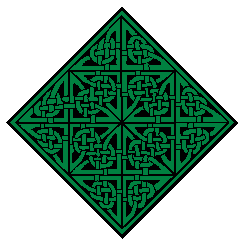
|







